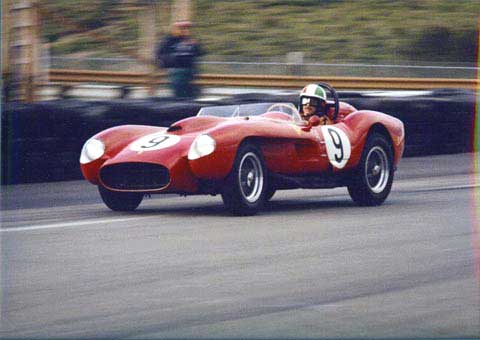
Crane enjoying the echo of that famous song at the exit of Laguna Seca’s famous Turn Eleven in 1978. Notice “vintage” Italian flag helmet with “disappearing” bottom half.
Ferrari’s “Song of the Twelve”
reverberated off the concrete wall at the exit of turn eleven and filled the little canyon that contains Laguna Seca Raceway near the California coast. The legendary Italian aria filled my helmet too as the 250 Testa Rossa sang a 6000-rev crescendo. I pushed in the clutch and slid the heavy steel gearlever through its gate to select the next chorus.
I saw it as an historical move. Far more serious practitioners had made the same move better and for more important reasons in this car’s history. I was no more that a lucky interloper in a remarkable place. Driving any Ferrari puts you in contact with a brief vital chord of history, but a Testa Rossa carries the soul of the classic Ferrari.
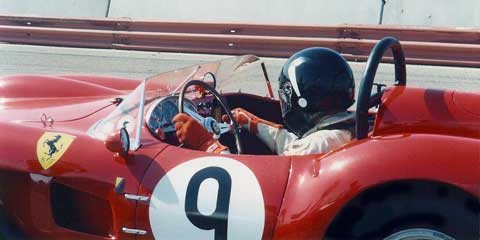
Even typers like to shift — 1995. Notice the new helmet logo — apropos activity within.
The genius of Gioacchino Colombo created the conceptual Ferrari V-12 in 1946, but development wizard Luigi Bazzi and gifted Aurelio Lampredi made it work. Then young Lampredi designed a larger, stronger version, commonly referred to as the “large block V12.†It proceeded to defeat the nearly invincible Alfa 159 in 1951 and changed the course of both Grand Prix racing and the Scuderia Ferrari. The young designer’s success caused Colombo to leave Ferrari.
Despite Colombo’s departure, the small block V12 thrived, from the initial 125 (1500cc) 1947 variant, increasing in size to a 166 (2000cc), a 195, (2340cc) and a 212 (2544cc). The 250MM engine that followed was the precursor to the 1954 250GT engine, a 3 liter block which retained the SOHC head and would see action in both Ferrari sports racing and grand touring cars for the next decade, including use in the fabled Testa Rossa. In the meantime, Lampredi’s big block engines continued in use for both Formula One and the factory long distance race cars.
In addition, Lampredi was challenged to produce a 2-liter twin-cam four, a sudden departure from the already traditional V12 practice. Two world championships in 1952 and 1953 proved that Lampredi had it right. The Ferrari fours grew from 2-liters through 2.5, 3 then 3.5-liters and brought dozens of victories to the Scuderia.
Il cavalino rampante continued its ascent under the design leadership of Lampredi. But when Lancia withdrew from racing in 1955, Ferrari inherited their sensational new D50 Grand Prix cars, its development plans and a number of research projects. Included in the arrangement was design consultant Vittorio Jano. Seeing the new team as an affront to his successes, Lampredi, like his mentor, made a dispirited departure. For the remainder of his career he created brilliant engines for Fiat, most of which were unsung successes in small sedans.Â
Vittorio Bellentani from Maserati and young Andrea Fraschetti joined Alberto Massimino to replace Lampredi. The new team quickly made alterations to strengthen the bottom-end of the existing Mondial 2-liter four. Its recalcitrant transaxle was replaced by a full-synchro gearbox in unit with the engine and a simple live rear axle. For reasons unrecorded, the cam covers on the revised engine were painted a crackle-finish red, and the new race car became the Testa Rossa—Red Head.
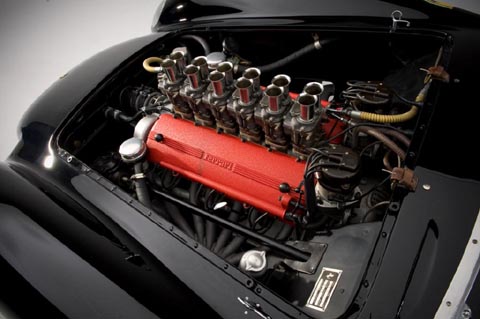 Testa Rossa camcovers are highlighted by the black background of the Ferrari 250 Testa Rossa offered by RM at their Ferrari Leggenda e Passione auction in Maranello May 17, 2009. Courtesy RM Auctions.
Testa Rossa camcovers are highlighted by the black background of the Ferrari 250 Testa Rossa offered by RM at their Ferrari Leggenda e Passione auction in Maranello May 17, 2009. Courtesy RM Auctions.
First Touring built the bodies for the 1956 500R, then Scaglietti, who was becoming the carrozzeria of choice for Ferrari racing cars. Late in 1956 Ferrari introduced a revised Testa Rossa for the 1957 FIA Appendix C regulations. Scaglietti’s new shape for the 500TRC was much lower and more elegant than its predecessor. It was so pretty it probably inspired buyers.
Through 1956 and 1957, big four-cam V-12s powered the factory’s successful sports racing cars, but the 250 GT berlinettas also found success with the Colombo-dimensioned 3-liter, SOHC V-12. It proved enormously strong and reliable, often finishing ahead of the team’s more complex sports cars. The 250 record became so compelling that Ferrari commissioned a new sports racing car based on the simplicity of the 500 TRC chassis and a further developed and reinforced version of the 250 GT engine. Scaglietti was asked to shape another elegant roadster to inspired the next group of gentlemen racers. Again the result was both beautiful and effective, with great sweeping side cutouts to help cool the front brakes. The works cars used more complex rear-mounted gearboxes with de Dion axles and cleaner sides for improved aerodynamics. Several additional Testa Rossa types were developed for factory competition until 1961, but the simple live axle, “pontoon-fendered,†customer 250 Testa Rossa became the most loved Ferrari racing roadster of all time. Thirty years after its introduction, the 250 TRs were selling for more than the factory team’s budget for all the years it was raced. Now fifty years later the 250 TR offered by RM at their Ferrari Leggenda e Passione sale in Maranello in May (add link) will likely bring more than the entire factory budget for the racing life of the Testa Rossa.
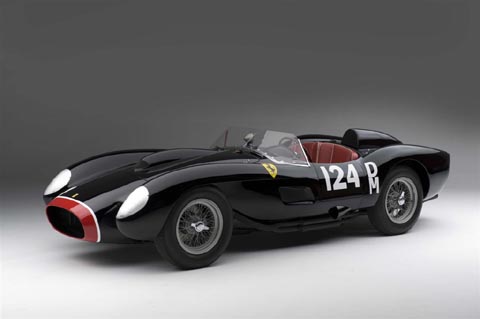 The Ferrari 250 Testa Rossa offered by RM at their Ferrari Leggenda e Passione auction in Maranello May 17, 2009. Courtesy RM Auctions.
The Ferrari 250 Testa Rossa offered by RM at their Ferrari Leggenda e Passione auction in Maranello May 17, 2009. Courtesy RM Auctions.
Many of the resilient Testa Rossas never retired. Finally, when real competition was no longer an option, vintage racing became their venue. Young enthusiasts bought them because they were relatively inexpensive, reliable and they could always be counted upon to go fast, look good and assemble the biggest crowd in a vintage racing paddock.
I opened this little history lesson from the cockpit of David Love’s 250 TR. It was my second invitation to use the car he had bought 27 years before and has raced nearly every year since, first in real racing until its competitive edge had worn smooth, then directly into vintage racing. Much of the Testa Rossa’s intrinsic value lies in its fundamental strength. Ferrari 250 V-12 engines can be vintage raced for years with little more than diligent maintenance. I know of at least two cars that were raced beyond a decade without the engines being disassembled. Its road limits are soft and forgiving under low gear power out of a corner or in high-speed drifts through fast sweeping bends. The car’s balance and friendly nature could seduce the most ardent critic. The Testa Rossa has earned its place in the top echelon of racing classics and because of this, the Red Head’s evocative name has never wandered far from the international automotive lexicon.
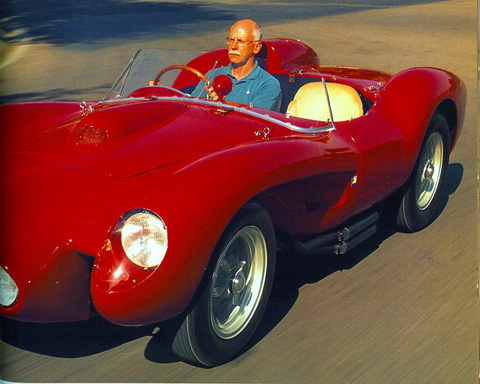
Crane in Ferrari 250 TR 0666 when owned by Chuck Betz and Fred Peters. It was the factory prototype and was modified to test both a front gearbox / live axle and a transaxle / de Dion tube rear suspensions in search of a 3-liter championship. The “customer†cars got the former, while the Works cars got the latter.
The Commendatore was never one for rearward vision, so the name lost its importance at the end of the TR’s last Works entry. But when the second series Boxer, the BB 512, was to be replaced by a more exotic and race-bred sibling, the name reappeared. But like his friend Pinin Farina, Ferrari coined a new name with the resonance of history. The new car would be called Testarossa, and it would be shaped by the traditional genius of Pininfarina. See the “A Car Life by Larry Crane†archive for a quick look at the first edition of the Testarossa.
Fantastic ….. as always!!
George.
Great insight into these stunning racers … Bravo!
BTW, I recently started a series I call “The Office”, and by coincidence, I’ve illustrated the cockpit of the Betz and Peters TR that you are driving in the last shot. You can see it here:
http://automobiliart.blogspot.com/2009/02/office-series-1957-ferrari-250-tr-testa.html
Again, thanks for stories.
Cheers!
Paul